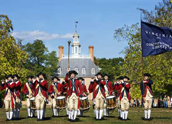HISTORICAL ATTRACTIONS / THE HISTORIC TRIANGLE
The pearl of “Historic Virginia” nestles on the peninsula between the York and James Rivers. Here, in the area known as the Historic Triangle, you’ll discover a cluster of sites that preserve the deepest roots of our modern American life: Colonial Williamsburg, Jamestown Island, and Yorktown.
Colonial Williamsburg
Greeting and accommodating more than one million visitors each year, the “walking community” of Colonial Williamsburg is a peerless and magnificent showpiece of 18th century life. This re-creation of 17th and 18th century Virginia comes alive in lovingly restored buildings that reflect colonial homes and business life. Costumed interpreters make it possible to enjoy a realistic encounter with an artisan or craftsman of the time, from blacksmiths to weavers and candle-makers.
Although Williamsburg is celebrated as the nation’s largest historic tourist attraction, its transformation and phenomenal success began with the vision of a local priest in the 1920s named WAR Goodwin. Perceiving automobiles as destructive to American life, he ironically approached Henry Ford with a request for funds to restore the 18th century atmosphere that once prevailed in Williamsburg. Ford refused.
Nevertheless, Goodwin’s idea sparked the imagination of another wealthy investor, John D. Rockefeller, Jr. After donating more than $70 million to the Williamsburg restoration project over a number of years, John D. Rockefeller and his wife Abby Aldrich moved into the Bassett Hall in the mid-1930s. Rockefeller later established an endowment so that restoration and preservation would continue after his death. This legacy, known today as the Foundation for Colonial Williamsburg, combines with The College of William and Mary to form the financial and economic powerhouse behind the community.
Jamestown
Short-lived but historically monumental, Jamestown was the site where the 104 boys and men disembarked from the Discovery, the Godspeed, and the Susan Constant to form the first permanent English settlement in the New World. Before disease, starvation, and attacks by Native Americans completely devastated the small group, the survivors moved inland to the area we know as Williamsburg.
Nearly 400 years later, the original Jamestown is a collection of ruins, historical markers, visitor’s centers, and archaeological digs. Nearby, Jamestown Island National Historic Site offers “living history” tours. On site are paintings, models, dioramas, and intriguing 17th century objects. The only standing structure that remains from the 17th century town is the old church tower, part of the original brick church.
The modern visitor’s center known as Jamestown Settlement offers a museum with changing exhibits, a reconstruction of the 1607 James Fort, a Native American village, and full-scale replicas of the three ships that carried the early settlers to Jamestown.
Yorktown
Founded in the late 1600s when the General Assembly in Jamestown passed the Port Act, Yorktown quickly became a bustling tobacco port. However, the site’s claim to fame would not come for nearly 100 years in the fall of 1781. It was from Yorktown that General George Washington reported back to the Continental Congress: “I have the honor to inform Congress, that a reduction of the British Army under the command of Lord Cornwallis, is most happily affected.” This battle news was followed by an official exchange at Surrender Hill, marking the end of the Revolutionary War. In the words of the cliché, “The rest is history.”
Yorktown was later besieged by Union troops led by General George McClellan. Many of the fortifications from this era, and even from the Revolutionary War, remain intact. In addition to historic landmarks, visitors discover living history exhibits and costumed actors who enthusiastically reenact every role from continental soldiers to colonial farmers. Historic taverns, churches, meeting rooms, and homes are sprinkled throughout the Colonial National Historical Park.
For more information on one of our nation’s most richly historic area, the following resources will be helpful:
Colonial Williamsburg Foundation
Williamsburg 757-229-1000
www.history.org
Colonial National Historical Park
Yorktown 757-898-3400
www.nps.gov/colo
Yorktown Victory Center
Colonial Parkway
Yorktown 757-898-2410
www.nps.gov/yonb
Jamestown National Historic Site
Yorktown 757-856-1200
www.nps.gov/jame
Williamsburg Area Convention & Visitor’s Bureau
Williamsburg 757-229-6511
www.visitwilliamsburg.com


